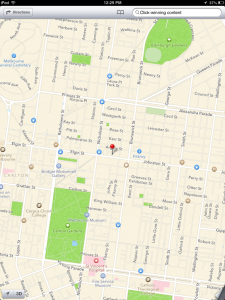Nearly a year and a half ago, I predicted that Apple was hatching a ” secret plan to kill the cash register.” Now that plan has a name: It’s called iBeacons.
At the end of this column, I’m going to tell you a stunning fact about iBeacons. But first, let’s understand what Apple is hatching.
Apple cryptically introduced the iBeacons initiative at its developers conference in June, identifying the new technology as a feature of the iOS software developers kit (SDK).
In fact, iBeacons is a Bluetooth-based micro-locations system (think very accurate GPS that can be used indoors). But instead of being used by people to determine their own locations, it’s used by retailers, museums and businesses of all kinds to find out exactly where people are, so they can automatically serve up highly relevant interactions to customers’ phones.
Apple has not publicly revealed technical details about iBeacons, but it did tell developers what the technology is for and generally how it works. According to Apple, iBeacons is used for the following:
Region monitoring: To identify the general area the user is in, such as a stadium or a mall.
Ranging and micro-locations: To determine how far the user is from something, and specifically where the user is. The iBeacons technology may be able to detect ranges from two inches to 160 feet.
It works by monitoring signals from Bluetooth LE (BLE) beacons.
(Apple was the first maker of laptops and smartphone handsets to support BLE – also known as Bluetooth Smart, Bluetooth Smart Ready and, formerly, Bluetooth 4.0 — on all of its products, including tablets.) Just about any BLE device can support iBeacons; that includes any iOS device and BLE devices not made by Apple.
In a presentation to developers, Apple gave multiple examples of how iBeacons might work in the real world. For instance, the company said that the technology can determine exactly where a user is. If you walked into, say, Jay’s Donut Shop, iBeacons would know for certain that you had walked into Jay’s Donut shop, whereas other location apps might use GPS, Wi-Fi and cellular triangulation to produce a list of guesses about where you were. A check-in wouldn’t even be required.
According to Apple, you could order donuts before you stepped foot into Jay’s Donut Shop. Upon your arrival, your iPhone would display a QR code that a clerk could scan to verify that you’re really you and not a would-be donut thief. Your donuts would already be bagged, and the receipt would be in your phone.
This scenario could be replicated for just about any brick-and-mortar retail store.
Apple showed this slide during the keynote of its Worldwide Developers Conference.
Also, iBeacons devices could be placed all over a store, and the system could send discount offers to iBeacons users as they entered particular departments. One or more iBeacons could be used as electronic cash registers.
There are other obvious scenarios that Apple didn’t specify. They include the following:
- Stores reaching out and giving coupons and advertising to passersby on the sidewalk or in cars.
- “E-Z Pass”-style building access — doors would unlock and open as authorized users approach. A more secure version of this might require a fingerprint scan on the iPhone.
- Far-more-accurate Passbook location-based alerts.
- Tour-guide features that could give specific, detailed information on a phone or tablet within a single museum or across an entire city (with iBeacons placed at the specific landmarks and attractions).
- Theme park family tracking, E-Z Pass-type access to rides and quick, wireless concessions sales.
- Navigation aids for sight-impaired or physically disabled users inside buildings.
- Self-service checkout. A customer could scan the labels on clothing, process the transaction on the phone, then stroll out of the store with purchases in hand (the alarm would be de-activated for those items).
iBeacons already being announced
What Apple is doing with iBeacons seems to me to be an uncharacteristic move for the company: It’s letting other companies get involved with its iBeacons technology.
A Polish company called Estimote, which has an office in Silicon Valley, has already announced pricing for iBeacons-supporting devices: Three of them will cost $99. (Note that three iBeacons is plenty for even a large store.)
The initial price for Estimote iBeacon devices is three for $99. And three is plenty to cover even a large store.
A company called Roximity will lease you their iBeacon-supporting gadgets for $10 per month each.
Now we know why WifiSLAM
Apple announced in early August the acquisition of a startup called WifiSLAM, a company that specialized in “indoor GPS.” Specifically, WifiSLAM’s technology triangulates both Wi-Fi and Bluetooth (BLE) to enable precise location tracking indoors.
In the context of iBeacon, Apple should be able to know how far a user is from both iBeacons and Wi-Fi hotspots, pinpointing the user’s location to within inches.
Just a touch upon Touch ID
The final piece of the puzzle for the point-of-sale and transaction part is user authentication, which Apple revealed with the introduction of Touch ID fingerprint sensors on the iPhone 5S line. (I suspect all phones announced in the future will also have Touch ID sensors.)
The less insightful commentary on Touch ID suggested that its purpose is to protect the cat videos and electronic receipts on your iPhone — in other words, protect the iPhone itself. But the real purpose of Touch ID is to authenticate users. “Yes, it’s really Mike Elgan — go ahead and process that payment using his credit card on file with iTunes.”
One killer fact about iBeacons
People have been waiting for years for eWallets and virtual cash registers, as well as location-based marketing and automated check-ins to take off.
For the most part, we’ve been waiting for NFC, a short-range, low-power wireless technology that requires a special chip in both devices connecting to each other. Some Android phones, for example, have shipped with NFC chips. And every iPhone announcement of the last few years has been accompanied by speculation that, finally, Apple would build NFC into phones.
The expectations have been that the road to ewallets, virtual cash registers, location-based marketing and automated check-ins would be a long and arduous one, with full adoption someplace in the misty future.
But here’s the killer fact about iBeacons: Every iPhone 4S, iPhone 5, iPhone 5c and iPhone 5s already supports iBeacons and everything iBeacons can offer — that’s probably about 200 million actively used phones (give or take 50 million), with Apple’s selling dozens of millions more per quarter.
The equipment required for retailers to embrace iBeacons is a rounding error – next to nothing on the hardware side.
And Apple is pushing app developers to build features and functionality into the system.
There will be no long buildup and chicken-and-egg hold-up around Apple’s plan to kill cash registers, as well as implement location-based advertising and promotions.
Most iPhones in use already support it.
I think that very soon iBeacon solutions will be showing up all over the place.
Apple’s plan is so good — so elegant and cost effective – that it won’t just kill cash registers. It will probably kill NFC, too.





